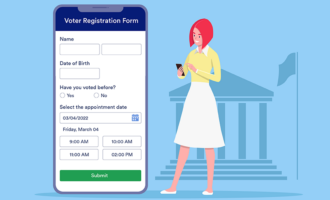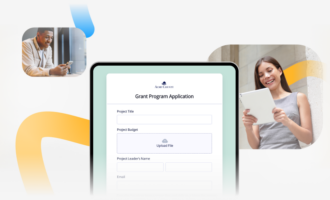Is your mobile phone always within reach?
For most people, I’d be willing to bet the answer is yes.
Even if you aren’t part of the millennial generation (who spend nearly a quarter of every day on their phones), you’re still likely using your phone fairly frequently to communicate with friends and family, check work emails, buy groceries, or order dinner. Mobile phones offer convenience, speed, and efficiency, a fact that the private sector hasn’t failed to notice. Industries such as hospitality, retail, and others now conduct more business on mobile than ever before, and it’s time for the public sector to follow suit.
Why is it so important for governments to embrace mobile? In this article, we look at the benefits associated with mobile government services and explore some of the design considerations they require. And if you’re ready to start offering mobile access to government services now, we also identify an easy-to-use tool that can help you get your initiative up and running fast.
The positive impacts of mobile government services
An increasing number of government agencies are looking for ways to provide digital access to their services and information, an effort commonly referred to as a “digital transformation.” Offering services over mobile phones is a major component of digital transformation, and it’s one that many public service leaders are prioritizing.
“Let’s not mince words here,” says Justin Insalaco, retired police officer and a strategic adviser to Atlas One, which offers public safety digital communications. “Mobile technology is pivotal in today’s world, and any government body embarking on a digital transformation journey without a mobile-centric strategy simply hasn’t done its due diligence. This is not a mere opinion but a fact grounded in concrete data.
“As of May 2023,” he says, “Oberlo reports that 67.8 percent of all web visits or internet activity are mobile-based. Yes, there’s been a tug-of-war between desktop and mobile usage over the past few years, likely due to the work-from-home shift during the pandemic. But even then, mobile accounted for 60 percent of activity last year, and it has already gained a seven percent edge over desktop in less than a year.
“Simply put, a digital transformation strategy that relies on desktop-based systems is not a transformation strategy at all.”
The key benefits mobile governments provide are instant access, increased efficiency, and convenience. With mobile, citizens can access services whenever they want, without having to go to a government office in person or use a desktop for digital services. This makes it easier for citizens to perform government-related tasks, such as paying for parking tickets or participating in a virtual town hall meeting, for example. Instant access to government services increases citizen engagement and makes it more likely that constituents will view your government agency favorably.
Mobile also offers time savings and increased efficiency, especially for citizens who are physically unable to visit government offices in person or who aren’t able to access desktop devices. And let’s not forget about the convenience factor. After all, if citizens are used to accessing services and products via mobile for all other aspects of their lives, they’ll want the same ability with public sector organizations as well.
Mobile-optimized solutions also make it possible for government employees — especially those who work outside the office in the field — to continue to do their jobs effectively from anywhere. Transportation, public works, and emergency personnel, to name just a few, are constantly on the move and would benefit from having access to internal systems from their mobile phones. They could easily log work that’s in progress, for instance, or document input from citizens in the field.
Mobile government design considerations
Offering government services over mobile isn’t as simple as making a mobile-optimized website (though that’s a good starting point). It’s important to take into account specific design features that apply to the mobile experience.
Insalaco notes that there’s been a sharp decrease in the number of filled positions in the public sector, which is why it’s more crucial than ever for government agencies to use technologies that make administrative functions easier and more efficient. Developing mobile apps for employees can help government offices reach higher levels of efficiency, even amid personnel shortages.
It’s vital that mobile government technologies create a smooth user experience — whether the users are employees or citizens. Going from an in-person government interaction to a desktop or mobile interaction should feel seamless. To create that feeling of consistency, apply government branding elements to your mobile services so they match your in-person and desktop experiences, and make your mobile applications easy to use.
Here’s another design challenge to consider: Make sure your mobile government services are designed specially for this medium. For example, some applications act the same way on mobile as they do on a desktop — and they neglect to take advantage of mobile-specific features. For example, geolocation and touch screens are unique to mobile and can greatly enhance certain mobile government services if they’re part of the design.
Governments also need to consider usability and functionality on different types of mobile phones and conduct thorough testing to ensure mobile services work on all types and brands of mobile devices.
Jotform: A mobile government solution for data collection and more
Jotform is a mobile-optimized form builder that many public service organizations use.
You can make sure your citizens have access to all government-related forms — including permit and license applications, registrations, and more — anytime, anywhere by using Jotform Mobile Forms. It’s also an excellent solution for internal workflows — for everything from employee onboarding and training to scheduling, reporting, and more.
Concerned about security? Jotform offers robust security measures to ensure all data remains in the right hands. Plus, Jotform integrates with many other digital transformation solutions, which means you can easily add it to your regular workflows to make all your processes seamless for users from end to end.
When it comes to an enhanced mobile experience in government, try Jotform. Get started building your first mobile form today.
Photo by Karolina Grabowska































Send Comment: